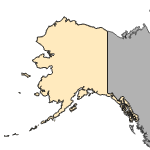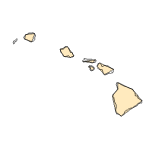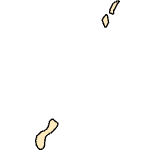Xiphophorus maculatus × variatus
(platyfish/swordtail)
Fishes
Exotic Hybrid |
|
Common name: platyfish/swordtail
Synonyms and Other Names: southern platyfish x variable platyfish.
Identification: See Gordon and Gordon (1957) and Atz (1962).
Size: Similar to parental species
Native Range: Not applicable.



|

Alaska |

Hawaii |

Puerto Rico &
Virgin Islands |

Guam Saipan |
Hydrologic Unit Codes (HUCs) Explained
Interactive maps: Point Distribution Maps
Nonindigenous Occurrences:
This hybrid has been recorded for Brevard County, Florida (Courtenay et al. 1974), a location with many fish farms at that time.
Table 1. States with nonindigenous occurrences, the earliest and latest observations in each state, and the tally and names of HUCs with observations†. Names and dates are hyperlinked to their relevant specimen records. The list of references for all nonindigenous occurrences of Xiphophorus maculatus × variatus are found here.
Table last updated 12/14/2025
† Populations may not be currently present.
Means of Introduction: Most likely introduced through aquarium releases or fish farm escapes.
Status: Reported from Florida, but there is no evidence of establishment.
Impact of Introduction: The impacts of this species are currently unknown, as no studies have been done to determine how it has affected ecosystems in the invaded range. The absence of data does not equate to lack of effects. It does, however, mean that research is required to evaluate effects before conclusions can be made.
References: (click for full references)
Atz, J.W. 1962. Effects of hybridization on pigmentation in fishes of the genus
Xiphophorus. Zoologica 47:153-181.
Courtenay, W. R., Jr., H. F. Sahlman, W. W. Miley, II, and D. J. Herrema. 1974. Exotic fishes in fresh and brackish waters of Florida. Biological Conservation 6(4):292-302.
Gordon, H., and M. Gordon. 1957. Maintenance of polmorphism by potentially injurious genes in eight natural populations of the platyfish, Xiphophorus maculatus. Journal of Genetics 55(1):1-44.
Other Resources:
Fact Sheet for Xiphophorus maculatus - USGS Nonindigenous Aquatic Species Database
Fact Sheet for Xiphophorus variatus - USGS Nonindigenous Aquatic Species Database
Author:
Leo Nico, Pam Fuller, and Bill Loftus
Revision Date: 6/29/2023
Peer Review Date: 9/18/2012
Citation Information:
Leo Nico, Pam Fuller, and Bill Loftus, 2025, Xiphophorus maculatus × variatus: U.S. Geological Survey, Nonindigenous Aquatic Species Database, Gainesville, FL, https://nas.er.usgs.gov/queries/FactSheet.aspx?SpeciesID=873, Revision Date: 6/29/2023, Peer Review Date: 9/18/2012, Access Date: 12/15/2025
This information is preliminary or provisional and is subject to revision. It is being provided to meet the need for timely best science. The information has not received final approval by the U.S. Geological Survey (USGS) and is provided on the condition that neither the USGS nor the U.S. Government shall be held liable for any damages resulting from the authorized or unauthorized use of the information.